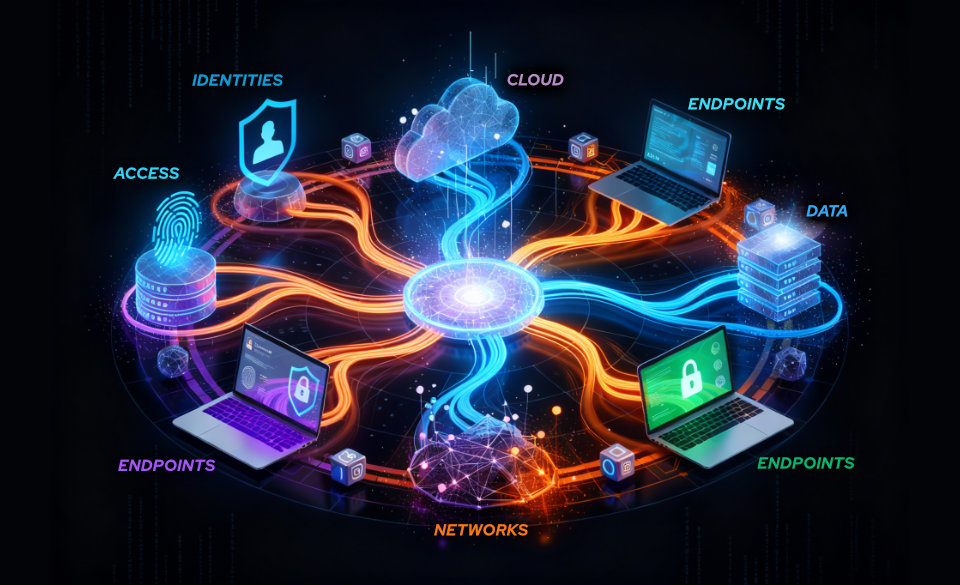
IT Environment Cybersecurity: On-Premises, Cloud, and Hybrid
20 de March de 2025
Cybersecurity in Photovoltaic Plants: Safeguarding the Future of Energy
3 de April de 20251. What is Quantum Computing?
Quantum computing is a paradigm of information processing based on the principles of quantum mechanics. Unlike classical computing, which uses bits that represent either 0 or 1, quantum computing employs qubits, which can exist in a superposition of both states simultaneously. This enables exponentially faster information processing for certain types of problems.
2. How It Works
Quantum computing relies on several fundamental principles of quantum mechanics that allow for information to be manipulated in completely different ways than in classical systems.
– Quantum Superposition
Unlike a classical bit, which can only take the value of 0 or 1, a qubit can be in a linear combination of both states at the same time:
These are complex coefficients representing probabilities (their squared moduli must sum to 1). Thanks to superposition, a system of qubits can represent multiple states simultaneously, allowing for massive parallel data processing.
– Quantum Entanglement
Entanglement is a property in which two qubits can be correlated in such a way that the state of one instantly affects the other, regardless of the distance between them. Mathematically, an entangled pair of qubits can be expressed as:
If one of these qubits is measured and results in 0, the other will instantly collapse to 0 as well, no matter how far apart they are. This property is key to quantum cryptography and secure information transmission.
– Quantum Interference
Quantum interference allows correct solutions to be amplified and incorrect ones to be canceled out during computation. To achieve this, quantum gates like the Hadamard gate (H), which creates superposition, are used:
This enables undesirable states to interfere and cancel each other out, leaving only the correct solution at a certain point in the calculation.
3. Quantum Hardware
The development of quantum hardware is one of the greatest challenges. Currently, several competing technologies exist:
- Superconducting qubits (IBM, Google): based on Josephson junction circuits.
- Trapped ions (IonQ, Honeywell): use charged atoms confined by electromagnetic fields.
- Photonic quantum computing (PsiQuantum): manipulates individual photons.
- Quantum dots and neutral atoms: experimental approaches in development.
Each technology has advantages and challenges in terms of stability, scalability, and error correction.
4. Quantum Algorithms
Quantum computers run specific algorithms such as:
- Shor’s Algorithm: Factorizes integers in polynomial time, threatening RSA cryptography.
- Grover’s Algorithm: Searches unsorted databases quadratically faster than classical algorithms.
- Quantum Optimization: Quantum annealing models used in logistics and materials design problems.
5. Applications of Quantum Computing
Quantum computing has applications across multiple fields:
- Post-Quantum Cryptography: Protection against quantum attacks through new protocols like lattice-based cryptography.
- Drug Discovery: Advanced molecular simulation to accelerate drug development.
- Logistics Optimization: Solving complex problems in transportation and resource management.
- Artificial Intelligence: Enhancing machine learning models through quantum neural networks.
6. Impact on Cybersecurity
One of the biggest challenges posed by quantum computing is its ability to break current cryptographic systems. Algorithms such as RSA, fundamental for secure communication and financial transactions, could become vulnerable due to quantum computers’ ability to factor large numbers rapidly. This could compromise the confidentiality and integrity of information in critical sectors such as banking and government communications.
To counter this threat, new post-quantum cryptographic methods are being developed to create mathematical problems so complex that not even a quantum computer could solve them easily. Additionally, Quantum Key Distribution (QKD) uses the laws of quantum physics to create virtually unbreakable encryption keys, offering unprecedented security in data transmission.
– Challenges and Opportunities
Quantum computing is one of the most potentially disruptive emerging technologies in the coming years. Its ability to process information exponentially faster than traditional systems makes it a powerful tool—but also a threat to global cybersecurity.
– Quantum Risk for Cybersecurity
One of the major challenges is the impact of quantum computing on current cryptographic systems. Today, internet security and many IT systems rely on encryption algorithms such as RSA, ECC (Elliptic Curve Cryptography), and AES (Advanced Encryption Standard). These methods depend on complex mathematical problems, like factoring large prime numbers or the discrete logarithm, which would take classical computers millions of years to solve.
However, quantum computing threatens to render these algorithms obsolete. With the advent of sufficiently powerful quantum computers, algorithms like Shor’s, developed in 1994 by Peter Shor, would efficiently factor large numbers, breaking current encryption. This means that all information protected by asymmetric cryptography (like blockchain private keys, digital certificates, or government data) could be decrypted in hours or even minutes.
– Solutions: Post-Quantum Cryptography and QKD
To mitigate these risks, experts are working on Post-Quantum Cryptography (PQC)—algorithms that remain secure even against quantum computers. Some of the main strategies include:
- Lattice-based cryptography: Security is based on mathematical problems that are difficult even for quantum computers.
- Code-based cryptography: Based on error-correcting codes that are also hard for quantum systems to crack.
- Hash-based cryptography: Uses mathematical operations unaffected by quantum computing power.
In addition, Quantum Key Distribution (QKD) promises to change the digital security paradigm. QKD allows the generation of encryption keys through quantum particles (photons) that, according to quantum mechanics, cannot be intercepted without altering their state. Companies like IBM, Google, and the National Security Agency (NSA) are already researching how to integrate QKD into government and commercial communication networks.
7. Developments in 2025
In February 2025, Microsoft announced the development of its first quantum processor based on topological qubits, called “Majorana 1.” This chip marks a significant step forward in the quantum race, using Majorana states (an exotic property of quantum physics) to build more stable and noise-resistant qubits.
Impact of this announcement:
- Greater viability of scalable quantum computers: Quantum computing is no longer just experimental—it’s edging closer to practical applications.
- Wake-up call for the cybersecurity community: The industry must accelerate the adoption of post-quantum cryptography to stay ahead of the threat.
- Public-private collaborations: Governments and tech companies are ramping up efforts to migrate to quantum-resistant standards.
Right now, everyone is talking about AI, but quantum computing promises an even greater technological leap.
All major tech companies are joining the development of this technology, like Willow, Google’s new quantum chip, with “extraordinary” computing power.
8. Conclusion:
Cybersecurity must evolve now
Quantum computing will bring enormous benefits in the future, but it also represents an unprecedented threat to global digital security. Businesses and governments must take action now to prepare for the transition to post-quantum security frameworks, ensuring that critical information remains protected in the coming decades.
The question is not if quantum computing will surpass current cryptography, but when it will.




